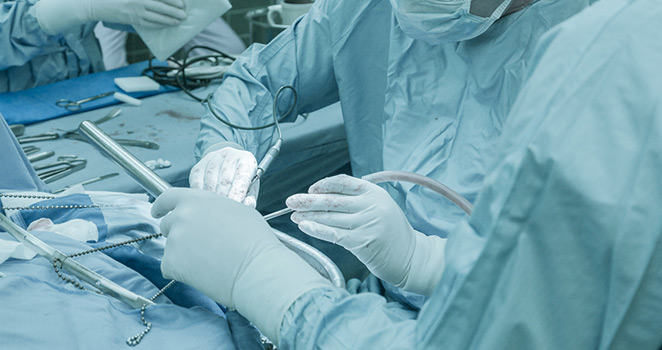Atrium Health Navicent Weight Management
Gastric Plication

About Gastric Plication
People who suffer from obesity and simply cannot lose the weight they need to through diet or exercise often turn to weight loss or bariatric surgery. A dangerous co-morbidity related to obesity such as diabetes, high blood pressure or sleep apnea makes this sort of surgery especially attractive. There are several types of weight loss surgery, including a new procedure called gastric plication.
The Procedure
Plication is a type of laparoscopic surgery. This means that instead of creating a large incision in the patient's abdomen, the doctor makes tiny incisions in which they insert trochanters, which then hold miniaturized surgical instruments and a camera attached to a monitor in the operating room. Laparoscopy cuts down on the risk of complications during and after the surgery.
Guided by the monitor, the surgeon makes a fold in the patient's stomach and sutures the ends together. Another fold is made over this one and sutured again. This reduces how much the stomach can hold by as much as 70 percent. Because of this, the patient feels full sooner than they would have without the operation. They cannot eat as much as they used to, which leads to rapid weight loss. Patients also find that they are not as hungry after gastric plication.
Unlike other bariatric surgeries where the stomach is actually partially removed and the digestive system is rearranged in a drastic way, gastric plication is reversible. It also does not interfere with the absorption of nutrients the way more extensive weight loss surgeries do. The operation takes about 40 minutes to two hours, and though it is not an outpatient procedure, the patient only has to stay in the hospital for a day or two.
Recovery From Gastric Plication
The patient needs to follow a restricted diet for about 6 weeks after surgery, and then take up a typical bariatric diet. For the first two weeks, the patient has a liquid diet. In weeks three and four, they can graduate to vegetable based soups and soups that lack carbohydrates. By weeks five and six, they can move on to fruits, yogurt and soups that are more substantial like chowders.
The patient consults with a bariatric dietician, who helps them adjust to the new diet. Foods are introduced slowly, and the bariatric diet should be fully in place after about six months. Patients are encouraged to plan, prepare their own meals, and keep a diet journal of everything they eat. Food should be weighed before it is prepared or eaten to make sure that the patient gets the vitamins and minerals that they need. Patients are also taught to eat slowly, to stop eating before they feel full, and to avoid alcohol with meals. They should also wait at least an hour after a meal before they drink. On the other hand, drinking some cool water a few minutes before a meal helps to make the patient feel full.
The patient can resume light exercise after about a month. Walking is the ideal exercise for a bariatric patient.
Studies have found that the complication rate from gastric plication is very low and that the weight loss is comparable to that of lap band surgery. In this surgery, a band is placed around the top of the stomach to form a tiny pouch. Diseases such as diabetes also improve with gastric plication.
Conclusion
Though gastric plication is still being studied as of 2016, it shows promise in that it helps patients lose weight, reduces obesity-related conditions, and has a low complication rate. The fact that it is reversible is also attractive to many patients who seek bariatric surgery.